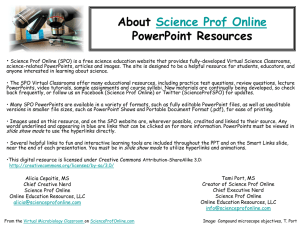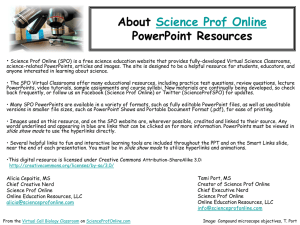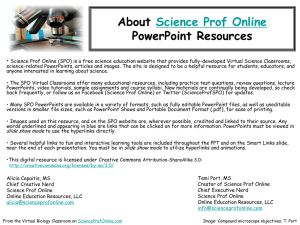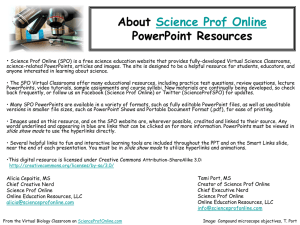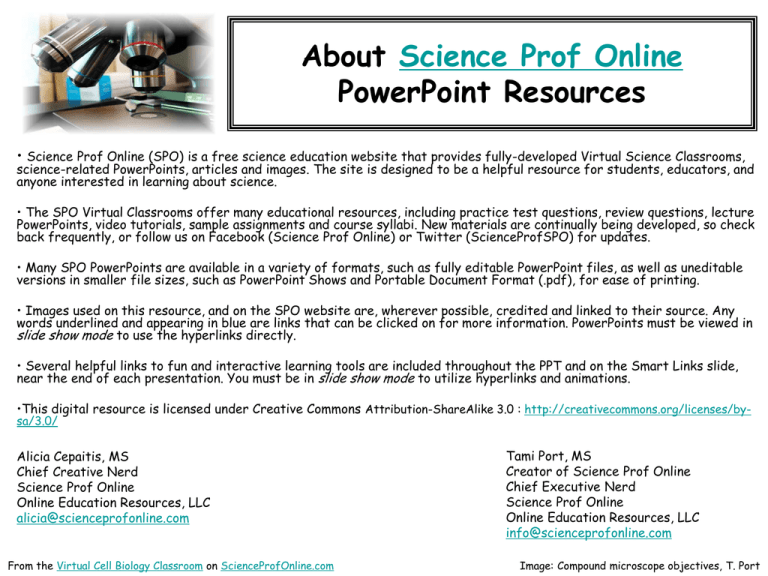
About Science Prof Online
PowerPoint Resources
• Science Prof Online (SPO) is a free science education website that provides fully-developed Virtual Science Classrooms,
science-related PowerPoints, articles and images. The site is designed to be a helpful resource for students, educators, and
anyone interested in learning about science.
• The SPO Virtual Classrooms offer many educational resources, including practice test questions, review questions, lecture
PowerPoints, video tutorials, sample assignments and course syllabi. New materials are continually being developed, so check
back frequently, or follow us on Facebook (Science Prof Online) or Twitter (ScienceProfSPO) for updates.
• Many SPO PowerPoints are available in a variety of formats, such as fully editable PowerPoint files, as well as uneditable
versions in smaller file sizes, such as PowerPoint Shows and Portable Document Format (.pdf), for ease of printing.
• Images used on this resource, and on the SPO website are, wherever possible, credited and linked to their source. Any
words underlined and appearing in blue are links that can be clicked on for more information. PowerPoints must be viewed in
slide show mode to use the hyperlinks directly.
• Several helpful links to fun and interactive learning tools are included throughout the PPT and on the Smart Links slide,
near the end of each presentation. You must be in slide show mode to utilize hyperlinks and animations.
•This digital resource is licensed under Creative Commons Attribution-ShareAlike 3.0 : http://creativecommons.org/licenses/bysa/3.0/
Alicia Cepaitis, MS
Chief Creative Nerd
Science Prof Online
Online Education Resources, LLC
alicia@scienceprofonline.com
From the Virtual Cell Biology Classroom on ScienceProfOnline.com
Tami Port, MS
Creator of Science Prof Online
Chief Executive Nerd
Science Prof Online
Online Education Resources, LLC
info@scienceprofonline.com
Image: Compound microscope objectives, T. Port
Metabolism
Diet &
Nutrition
Image: Stilleben, painting dated 1613, oil on canvas, by Floris van Dyck
From the Virtual Cell Biology Classroom on ScienceProfOnline.com
Metabolism
The Transformation of Energy
• Cells either get their
energy either by
________________ or
_________ ________.
• But a cell can’t just use
sunlight or nutrients to
run cellular reactions.
• What type of fuel is
needed to run a cell?
_____
From the Virtual Cell Biology Classroom on ScienceProfOnline.com
Cells Can’t Eat
Hamburgers
Image: Hamburger, Wiki
Cellular Respiration is
Carbohydrate Catabolism
• Organisms break down carbohydrates to create ATP for
running cellular reactions.
• The monosaccharide __________ is used most
commonly.
• Glucose catabolized by:
– Aerobic cellular respiration → Results in complete breakdown of glucose
to carbon dioxide, water and a lot of
ATP
– Anaerobic respiration & Fermentation → Only partially breaks down
glucose, into pyruvic acid and organic waste products and a little .
ATP
From the Virtual Cell Biology Classroom on ScienceProfOnline.com
Aerobic Cellular Respiration
From the Virtual Cell Biology Classroom on ScienceProfOnline.com
Images: Cellular Respiration, Regis Frey
What happens when oxygen is not
available?
__________ ________ ____________
•
Many anaerobic bacteria, and muscle cells that have
run out of O2, can make ATP by using something other
than oxygen as an electron acceptor
(nitrate, sulfate and carbon dioxide).
•
In anaerobic respiration, not all the ETC is used,
so less ATP is produced.
__________________
•
The ATP is produced during glycolysis.
•
The additional steps of fermentation do not produce any additional ATP.
•
Fermentation allows the breakdown of glucose to continue, followed by the oxidation
of NADH, so that some energy to be recovered in the absence of oxygen.
From the Virtual Cell Biology Classroom on ScienceProfOnline.com
Fermentation
From the Virtual Cell Biology Classroom on ScienceProfOnline.com
How do we metabolize proteins & fats?
.
Excess
amino acids can be used to synthesize ________, ________, and alpha
ketogluterate, which enters the Krebs cycle.
The glycerol & fatty acids of fats can also be converted to pyruvate and Acetyl CoA and
then enter cellular respiration.
From the Virtual Cell Biology Classroom on ScienceProfOnline.com
Metabolism:
Diet &
Nutrition
Stuff We Need
______nutrients:
• Carbohydrates
• Proteins
• Lipids
______nutrients:
• Vitamins
• Minerals
…and, of course, Water
From the Virtual Cell Biology Classroom on ScienceProfOnline.com
Image: Stilleben, painting dated 1613, oil on canvas, by Floris van Dyck
Carbohydrates
- Organic Macromolecules
• “________ hydrates”
• One carbon molecule to one water
molecule (_______)n.
Boogers
• Saccharide is a synonym for
carbohydrate.
• The prefixes on the word
“saccharide” relates to the _____
of the molecule (mono-, di-, tripoly-).
From the Virtual Cell Biology Classroom on ScienceProfOnline.com
Chocolate
Cake
You probably know that
chocolate cake is full of refined
sugars…carbs. You may not
know that boogers contain
carbs as well. Boogers are
dried-up mucus and dirty nose
debris. Mucus is made mostly
out of sugars and protein. Looks
like this little guy is double
dipping. Bon appetite!
Image: Sucrose, Wiki
Carbohydrates
- Organic Macromolecules
Monosaccharides
•
Q: What is a monosaccharide?
•
Q: Name a monosaccharide.
Disaccharides
•
Q: What is a disaccharide?
•
Q: Name a disaccharide.
Polysaccharides
•
Q: What is a polysaccharide?
•
Q: Name a polysaccharide.
Images: Glucose, Wiki; Sucrose, Wiki;, Starch, Wiki
From the Virtual Cell Biology Classroom on ScienceProfOnline.com
Carbohydrates -
Nutrition
•
Present in fruits, vegetables and grains…
essentially in plant matter, and low amounts in
dairy.
•
_______ carbs are not bad for you. They should
be the type of food you eat the most of (45 – 65%
of your daily food intake).
•
Complex carbs more nutrient-rich and harder for
your body to break down. They enter blood
stream more slowly, and include fiber.
•
Highly processed, refined carbs (such as sucrose) are
like “pre-chewed” food, so are very easily
digested. They quickly enter blood stream, and
can cause levels of the hormone _______ to
spike.
•
Consuming too many refined carbs can increase
your risk of Type 2 diabetes.
•
Q: Lets list some complex carb and simple carb
food sources on the board.
From the Virtual Cell Biology Classroom on ScienceProfOnline.com
Image: Vegetables, Gpics, Wiki; Grains, USDA; Fruits, Bill Ebbesen
Carbohydrates -
Fiber
•
Also called “bulk” or “roughage”.
•
Most are indigestible ___________________.
•
There are two main types of fiber with different
effects: insoluble fiber and soluble fiber.
•
______________________ improves elimination by
increasing stool bulk, preventing constipation and
decreasing risk of colon cancer.
•
Foods high in insoluble fiber: legumes, whole grains,
vegetables, fruits, nuts and seeds.
•
___________________ delays gastric emptying,
slows absorption of glucose into the bloodstream and
inhibits cholesterol absorption.
•
Good sources of soluble fiber : Fruits, vegetables, oat
•
The American Dietetic Association recommend 20 to
35 grams of total fiber each day. Most people get
FAR LESS than this.
bran, legumes, barley, nuts and seeds.
From the Virtual Cell Biology Classroom on ScienceProfOnline.com
Image: Vegetables, Gpics,USDA; Fruits, Bill Ebbesen
Proteins - Organic Macromolecules
Proteins are macromolecules, polymers composed of
____________ called _______________.
Amino acids contain a
1. base amino group ( -NH2)
2. acidic carboxyl group ( -COOH)
3. hydrogen atom
…all attached to same carbon atom (the α –
carbon…alpha carbon).
Fourth bond attaches α-carbon to a side group (--R)
that varies among different amino acids.
There are hundreds, but most organisms use only 21
amino acids to build proteins.
Side groups important … affects the way a protein’s
amino acids interact with one another, and how a
protein interacts with other molecules.
From the Virtual Cell Biology Classroom on ScienceProfOnline.com
Proteins -
Organic Macromolecules
Q:What kind of bonds link
amino acids together?
Q: Do you think these
bonds are … ionic?
covalent?
A dipeptide is 2 amino
acids linked together.
A polypeptide, more than
two.
From the Virtual Cell Biology Classroom on ScienceProfOnline.com
Image: Protein Primary Structure, Wiki
Protein
Structure
From the Virtual Cell Biology Classroom on ScienceProfOnline.com
Image: Levels of protein structure, M Ruiz
Proteins -
Dietary
•
__________ Proteins = contain all
essential amino acids necessary for
good health
•
__________ Proteins = are missing
some of the essential amino acids
necessary for good health
•
Essential Amino Acids = can’t be
synthesized by the human body
•
Percentage of daily food intake that
should be protein: 10 – 35%.
•
The amount of protein that a person
actually requires on a daily basis is
quite small, approximately 0.8 gram per
pound of body weight, depending on level
of physical activity. (That means, for example,
that 150# person needs about 120 grams or 4.25 oz of
protein daily.) – USDA
From the Virtual Cell Biology Classroom on ScienceProfOnline.com
Lentils, a vegetable protein, Paul
Goyette; Roasted chicken, Viperx, Wiki
Lipids
- Organic Macromolecules
Fats, Phospholipids, Waxes & Steroids
Hydrophobic macromolecules…insoluble in water.
Not attracted to water because …
non-polar covalent bonds linking carbon & hydrogen aren’t attracted to the
polar bonds of water.
From the Virtual Cell Biology Classroom on ScienceProfOnline.com
Images: Cholesterol, Wiki; Phospholipid Structure, Bryan
Derksen. Wiki Honeycomb, Wikii; Oil & Water, Kidipede
Lipids
- Organic Macromolecules
Fats
Fats and oils are made
from two kinds of
molecules:
• ____________
(a type of alcohol)
• _____________
(triglycerides)
Images: Oil & Water, Kidipede
From the Virtual Cell Biology Classroom on ScienceProfOnline.com
Lipids - Dietary Fats
Saturated fats
•
•
Mostly from animal sources.
•
Single bonds between the carbons in
their fatty acid tails (all carbons are
bonded to max number of hydrogens
possible).
Hydrocarbon chains fairly straight and
packed closely together … so
______at room temperature.
Unsaturated fats (oils)
•
Mostly from plant sources.
•
Have double bonds between some
carbons in the hydrocarbon tail,
causing bends or “kinks” in shape.
•
Kinks in hydrocarbon tails, so
unsaturated fats can’t pack closely
together … ________ at room temp.
From the Virtual Cell Biology Classroom on ScienceProfOnline.com
Lipids – Dietary Fats
•
We typically refer to them all as “Fats”, but remember, fats
are only one of several molecules known as lipids.
•
Phospholipids, steroids and true fats play an important role in
human nutrition, should get no more than 30% of calories from
fats., and the type of fat consumed is very important!
•
_____________ fatty acids (EFAs) are fats that the body
can’t make, but needs to take in from outside sources.
•
There are two families of EFAs: omega-3 and omega-6. Fats
from each of these families are essential, as the body can
convert one omega-3 to another omega-3, for example, but
cannot create an omega-3 from scratch.
•
When the EFAs were discovered in 1923, they were designated
Vitamin F. In 1930, further research showed that the two EFAs
are better classified with the fats than with the vitamins.
From the Virtual Cell Biology Classroom on ScienceProfOnline.com
Olive oil
has both
omega 3
and
omega 6
EFAs
Lipids
•
Phospholipids are a major
component of all cell
membranes.
•
Most phospholipids contain a
diglyceride, a phosphate group,
and a simple organic molecule
such as choline.
•
The diglyceride tails are
___________, but phosphate
group end is _____________.
•
So phospholipids are soluble in
both water and oil.
•
– Phospholipids
Tails from both layers facing
inward and the heads facing
outward = phospholipid
_______.
From the Virtual Cell Biology Classroom on ScienceProfOnline.com
Image: Cell Membrane, Wiki;
Phospholipids - Dietary
•
Because they are polar (hyprophobic
and hydrophilic parts) phospholipids
can act as an emulsifier in foods,
enabling oils to dissolve in water.
•
_______, which is made of
phospoholipid, is used in cooking
sprays and as a food emulsifier.
For example, lecithin keeps the
cocoa and cocoa butter in a candy
bar from separating.
Originally discovered in egg yolk,
and today commercially extracted
from soybeans, but widely present
in animal and plant tissues.
•
Remember, if we are eating cells,
we are eating phospholipids.
Steamed and salted, edamame (soybeans) is yummilicious;
as addictive as potato chips, but much healthier! Protein,
carbs and healthy fats all in one food item.
From the Virtual Cell Biology Classroom on ScienceProfOnline.com
Image: Edamame, Tammy Green
Lipids -
Waxes & Steroids
Waxes
•
Do not have a hydrophilic head: so
completely water insoluble.
•
Many plants, especially those found in
warm climates, produce waxes to reduce
dehydration.
Steroids
•
The central core of a cholesterol
molecule (4 fused rings) is shared by all
steroids,
•
Cholesterol is precursor to our sex
hormones and Vitamin D.
•
Our cell membranes contain __________
(in between the phospholipids) to help
keep membrane “fluid” even when
exposed to cooler temperatures.
From the Virtual Cell Biology Classroom on ScienceProfOnline.com
Image: Lava Lamp, Wiki; Cholesterol molecule, Wiki;
Phospholipids & Cholesterol, Cytochemistry.net
Calories
(really Kilocalories)
Q: What is a calorie?
Carbohydrates have ____ calories
per gram.
Fiber, a type of less-digestible
carb has ____ calories per
gram.
Proteins have _____ calories per
gram.
Fats have ___ calories per gram.
From the Virtual Cell Biology Classroom on ScienceProfOnline.com
How many calories
are in alcohol?
______ calories per gram.
But different drinks have
different strengths of alcohol.
So you can calculate the calories in
any alcoholic drink that you
consume with the following
calculation:
1.6 x alcohol % x oz in a glass
From the Virtual Cell Biology Classroom on ScienceProfOnline.com
To learn more about alcohol and your
health, see the “Rethinking Drinking”
website by the NIAAA (National Institute
on Alcohol Abuse and Alcoholism).
VITAMINS -
Micronurteints
•
________________ usually not produced by the
body, but essential in minute amounts for
metabolism.
•
Do not serve as a source of energy, but some help
facilitate many metabolic reactions as
_____________.
•
Example: B vitamins
- Eight water-soluble vitamins that play important roles in cell
metabolism.
-Once thought to be a single vitamin, referred to as Vitamin B
(much like how people refer to Vitamin C or Vitamin D).
- Later research showed that they are chemically distinct
vitamins that often coexist in the same foods.
- Supplements containing all eight B vitamins are generally
referred to as a vitamin B complex. Individual B vitamin
supplements are referred to by the specific name of each vitamin
(e.g. B1, B2, B3).
From the Virtual Cell Biology Classroom on ScienceProfOnline.com
Images: B vitamin caplets, Ragesoss
VITAMIN - B12
•
Largest and most complex of all the vitamins.
•
Sources of B12: Only bacteria can synthesize. Present in
animal products such as meat, poultry, fish (including
shellfish), and to a lesser extent, dairy. Vegans need to take
supplements.
•
Involved in many aspects of our health. Required for proper
red blood cell formation, neurological function, and DNA
synthesis.
•
10-15% of people are believed to be deficient in this vitamin.
•
B12 and Depression
Observational studies have found as many as 30% of patients
hospitalized for depression to be deficient in vitamin B12.
A recent cross-sectional study of 700 community-living, physically
disabled women over the age of 65 found that vitamin B12 deficient
women were twice as likely to be severely depressed as non-deficient
women.
The reasons for the relationship between vitamin B12 deficiency and
depression are not clear.
From the Virtual Cell Biology Classroom on ScienceProfOnline.com
Learn more about Vitamin
B12 from the website of the
Office of Dietary
Supplements, National
Institutes of Health.
Image:
PeriodicofTable
of B12,
Elements
Image: Molecular
structure
Vitamin
Wiki
MINERALS - Magnesium
•
Magnesium plays an important role in the production and
transport of _________.
•
It is also important for the contraction and relaxation
of muscles.
•
Magnesium is involved in the synthesis of protein, and it
assists certain enzymes in the body.
•
Over 300 enzymes require magnesium ions for their
catalytic action, including all enzymes using or
synthesizing ATP, or those that use other nucleotides to
synthesize DNA and RNA.
•
Human magnesium deficiency is common, with only
approximately 32% of the United States meeting the
RDA.
•
Low levels of magnesium in the body have been
associated with development of illnesses such as asthma,
diabetes, and osteoporosis.
From the Virtual Cell Biology Classroom on ScienceProfOnline.com
12
Mg
24.305
Magnesium
Images: Magnesium crystals, Warut Roonguthai;
Food sources of Magnesium, Peggy Greb
WATER
•
All chemical reactions of living things take place in water.
•
Many types of metabolic wastes can only be eliminated from body when dissolved in water.
•
The catalysis of materials requires water.
•
You may be able to survive weeks without
food, but wouldn’t last more than a few days
without water.
•
Human body ~ 65% water (even dense tissue
like bone is 33% water).
•
Food provides ~ 20% of total water intake.
Remaining 80% from water and other beverages.
•
Institute of Medicine advises men consume
roughly 3.0 liters (~ 13 cups) total beverages
daily & women consume 2.2 liters (~ 9 cups).
•
Q: What are some reactions that we have
discussed in class that involve water?
From the Virtual Cell Biology Classroom on ScienceProfOnline.com
Confused about what to eat?
• Eat more fresh food!
• Eat local food when you can!
• Complex carbs, balanced
wit protein and healthy fats.
• Reduce animal fats and refined sugar.
From the Virtual Cell Biology Classroom on ScienceProfOnline.com
Image: Edamame, Tammy Green
Confused?
Here are links to fun resources that further explain
nutrition:
•
Metabolism: Diet & Nutrition Main Page on the Virtual Cell
•
Cellular Respiration
•
“The Body Machine”
•
“Sugar, Sugar”
a song by The Archies.
•
Food Molecules
video from HowStuffWorks, a Discovery company.
•
“Do You Want Fries With That?” song by Tim McGraw.
Biology Classroom of Science Prof Online.
animation by Jay Phelan, “What is Life? A
Guide to Biology”, W. H. Freeman & Co.
music video by School House Rock.
(You must be in PPT slideshow view to click on links.)
From the Virtual Cell Biology Classroom on ScienceProfOnline.com
Metabolism Project
See the ScienceProfOnline Virtual Cell Biology
Classroom: Metabolism & Nutrition Lecture
for a printable Word .doc of this project.
OPTION 1
Macromolecules and Exercise
This is the most difficult assignment for earning full points,
and students often choose this option so that they don’t
have to read a book. I expect very detailed and complete
answers to all components of this assignment. Missing and
incomplete answers will result in missing and incomplete
points.
As a finished product, this Option 1 assignment should be
several pages long, and have required several hours to
complete (in addition to the time spent recorded what you ate for 3
days).
Here’s specifically what you have to do…
OPTION 2 & OPTION 3
The Most Awesome Book Report You’ll Ever Do!
There are two popular books, by Harvard MDs. The books are full of very useful knowledge for those
entering the field of Health Care. They provide a scientific and entertaining explanation of how our
bodies work and how the choices we make in diet and lifestyle impact our health on a cellular level.
Options 2 & 3 relate to reading one of these books and writing a report.
Here’s specifically what you have to do…
From the Virtual Cell Biology Classroom on ScienceProfOnline.com
Are you feeling blinded by science?
Do yourself a favor. Use the…
Virtual Cell Biology
Classroom (VCBC) !
The VCBC is full of resources to help you succeed,
including:
•
practice test questions
•
•
•
review questions
study guides and learning objectives
PowerPoints on other topics
You can access the VCBC by going to the Science Prof Online website
www.ScienceProfOnline.com
Images: Blinded With Science album, Thomas Dolby; Endomembrane system, Mariana Ruiz, Wiki




